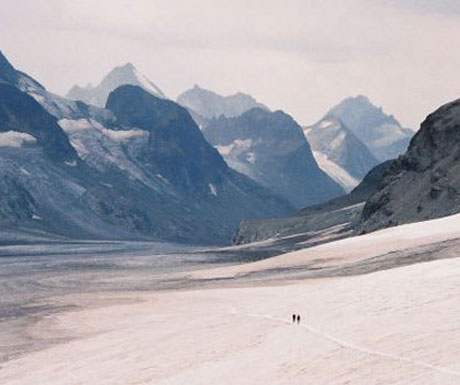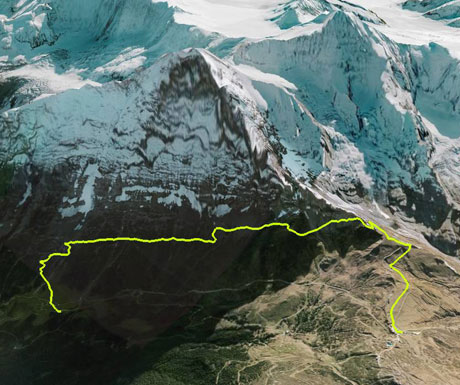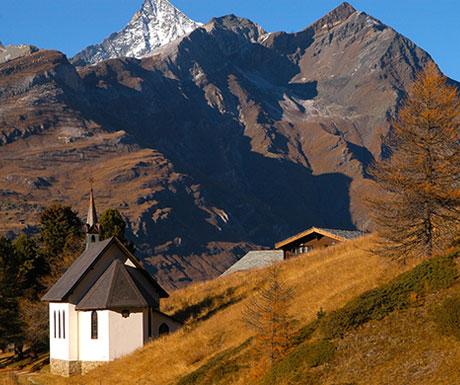The snow is melting, most resorts are now closed for skiing, only a few resorts can sustain the activity all year round. What am I going to do now that Ive packed my skis away? Well, to be honest theres a lot to do and see and the Alps provide a superb playground for summer activities every bit as captivating as skiing. One challenge Ive wanted to undertake for some time is the Haute Route, a ten day trek across the roof of the world.
The Haute Route-Zermatt to Chamonix
This is a spectacular and demanding summer hike. You will need to be able to manage round about 25k and a fair amount of climbing every day to complete this fairly taxing hike. You also need to pace yourself and start slowly as youll need a couple of days to acclimatise to the thinner air. There could be anything up to 25% less oxygen and at first you could find youre blowing hard. Once your body adjusts you should be fine. The route traverses below the summits of ten out of the twelve of the highest peaks in the Alps, and crosses several high passes. The highest pass is at 2964m. This is a world of diamond white glaciers and awe inspiring snow-capped peaks. The route also meanders through lush green alpine valleys with flower-covered meadows and picture-postcard villages, this is a trek of contrasts and a hike youll never forget. The route passes through the centre of both the French and Swiss Alps: two distinct cultural regions with different languages and architecture. This is a remote trek. Take a tent or sleep in a hut or refuge. In general these are open from mid-June until the first or second week in September. It is advisable to reserve a bed, particularly in the high season of mid July to mid August. One or two nights could be spent in valley hotels to catch up on hot showers and indulge in a bit of luxury, you will have earned it. The early season (June-mid July) is the quietest and most beautiful but beware of old snow on the higher paths which could be icy and dangerous and would make crampons essential.

The Eiger Trail – Eigergletscher to Grindelwald
This walk is a breeze compared to the Haute Route but as short as it is, its still pretty spectacular. Seven hours should see you complete this hike. Atthe Eigergletscher railway station, you walk a few steps back towards Kleine Scheidegg, cross the tracks of the Jungfrau Railway and hike up to thevantage point above the station. This is the beginning of the Eiger Trail, which also makes the Eiger an adventure for hikers as it actually runs alongthe foot of the famous Eiger North Wall. You can get up close and personal to the scene of heroic Alpine deeds and dramas and wonder how they everhad the nerve to tackle this brute. On the hike you enjoy impressive views of Grindelwalds wide valley basin, bordered to the east by the strikingsilhouette of the Wetterhorn. But most of all, the Eiger Trail gives you a sensational close-up impression of the Eiger North Wall. With a little luck,patience and keen eyesight, you may even be able to spot a roped team inching their way skyward. The trail leads gradually downhill and the widescree slopes give way to lush pastures carpeted with Alpine flowers. The last mound of scree is crossed in the Langenegg gully. Over time, hikers havebuilt a large number of small cairns here, this spectacle is pretty awe inspiring in its own right, maybe you could add your own! The part to Bonerahas exposed passages only suitable for sure-footed hikers with a head for heights. From Bonera the trail descends steeply to the glacier gorge andcontinues to Grindelwald. Here you can enjoy a well earned feast, you should be ravenous by the time youve finished. The hike is not too demandingbut shouldnt be underestimated.

Gornergrat to Zermatt
This hike is a personal favourite of mine. You catch the train in Zermatt and on the way up marvel at the engineering that allowed this train to ascendto near on 4,000mts. I think you would be hard pressed to think of a more spectacular journey by train. This is the easy part, although the first part ofthe hike down to the lake is fairly easy going too. Once at the lake you get the reflection of the Matterhorn in the icy waters and its good to stop herefor a while and just take it all in, its truly stunning. After the lake there are several stretches that are in shade and still retain the winter snow, theseparts can be hazardous and very slippery. You need to be sure footed here. The hike descends all the way down into Zermatt on well marked trails.Although the hike is all downhill, its not as easy as it appears as constantly walking downhill can play havoc with your thighs and your toes tend to jaminto the front of your foot ware, so make sure you boots are comfortable. There are so many places to stop and admire the view that you could easilydouble the length of the time taken to return to Zermatt. This walk should take about five hours. There is the opportunity to stop for lunch half waydown at the Albosco at Riffelalp restaurant if you want to make a day of it and break your journey in to two manageable halves. Don’t go crazy on the redwine though as your not out of the woods just yet, theres some way to go.
